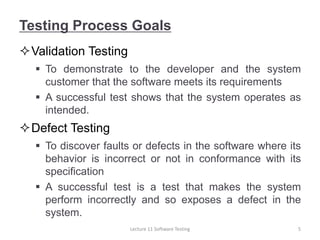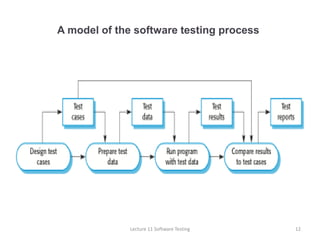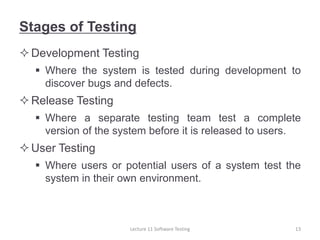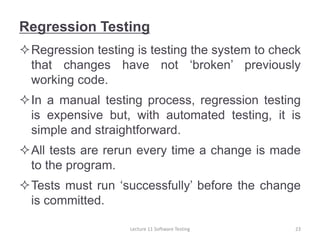Lecture 11 Software Engineering Testing Slide
- 1. Lecture 11 Software Testing 1 Lecture 11 Software Testing
- 2. Program Testing Testing is intended to show that a program does what it is intended to do and to discover program defects before it is put into use. When you test software, you execute a program using artificial data. You check the results of the test run for errors, anomalies or information about the program’s non- functional attributes. Testing is part of a more general verification and validation process, which also includes static validation techniques. It can reveal the presence of errors NOT their absence. Lecture 11 Software Testing 2
- 3. Program Testing Goals To demonstrate to the developer and the customer that the software meets its requirements. For custom software, this means that there should be at least one test for every requirement in the requirements document. For generic software products, it means that there should be tests for all of the system features, plus combinations of these features, that will be incorporated in the product release. To discover situations in which the behavior of the software is incorrect, undesirable or does not conform to its specification. Defect testing is concerned with rooting out undesirable system behavior such as system crashes, unwanted interactions with other systems, incorrect computations and data corruption. 3 Lecture 11 Software Testing
- 4. Validation and Defect Testing The first goal leads to validation testing You expect the system to perform correctly using a given set of test cases that reflect the system’s expected use. The second goal leads to defect testing The test cases are designed to expose defects. The test cases in defect testing can be deliberately obscure and need not reflect how the system is normally used. 4 Lecture 11 Software Testing
- 5. Testing Process Goals Validation Testing To demonstrate to the developer and the system customer that the software meets its requirements A successful test shows that the system operates as intended. Defect Testing To discover faults or defects in the software where its behavior is incorrect or not in conformance with its specification A successful test is a test that makes the system perform incorrectly and so exposes a defect in the system. 5 Lecture 11 Software Testing
- 6. An input-output model of program testing 6 Lecture 11 Software Testing
- 7. Verification: "Are we building the product right”. The software should conform to its specification. Validation: "Are we building the right product”. The software should do what the user really requires. Verification vs Validation 7 Lecture 11 Software Testing
- 8. V & V Confidence Aim of V & V is to establish confidence that the system is ‘fit for purpose’. Depends on system’s purpose, user expectations and marketing environment Software purpose • The level of confidence depends on how critical the software is to an organisation. User expectations • Users may have low expectations of certain kinds of software. Marketing environment • Getting a product to market early may be more important than finding defects in the program. 8 Lecture 11 Software Testing
- 9. Software Inspections: concerned with analysis of the static system representation to discover problems (static verification) May be supplement by tool-based document and code analysis. Software Testing: concerned with exercising and observing product behaviour (dynamic verification) The system is executed with test data and its operational behaviour is observed. Inspections and Testing 9 Lecture 11 Software Testing
- 10. Inspections and testing 10 Lecture 11 Software Testing
- 11. Software Inspections These involve people examining the source representation with the aim of discovering anomalies and defects. Inspections not require execution of a system so may be used before implementation. They may be applied to any representation of the system (requirements, design, configuration data, test data, etc.). They have been shown to be an effective technique for discovering program errors. 11 Lecture 11 Software Testing
- 12. A model of the software testing process 12 Lecture 11 Software Testing
- 13. Stages of Testing Development Testing Where the system is tested during development to discover bugs and defects. Release Testing Where a separate testing team test a complete version of the system before it is released to users. User Testing Where users or potential users of a system test the system in their own environment. Lecture 11 Software Testing 13
- 14. Development Testing Development testing includes all testing activities that are carried out by the team developing the system. Unit Testing: where individual program units or object classes are tested. Unit testing should focus on testing the functionality of objects or methods. Component Testing: where several individual units are integrated to create composite components. Component testing should focus on testing component interfaces. System Testing: where some or all of the components in a system are integrated and the system is tested as a whole. System testing should focus on testing component interactions. Lecture 11 Software Testing 14
- 15. Unit Testing Unit testing is the process of testing individual components in isolation. It is a defect testing process. Units may be: Individual functions or methods within an object Object classes with several attributes and methods Composite components with defined interfaces used to access their functionality. 15 Lecture 11 Software Testing
- 16. Component Testing Software components are often composite components that are made up of several interacting objects. For example, in the weather station system, the reconfiguration component includes objects that deal with each aspect of the reconfiguration. You access the functionality of these objects through the defined component interface. Testing composite components should therefore focus on showing that the component interface behaves according to its specification. You can assume that unit tests on the individual objects within the component have been completed. Lecture 11 Software Testing 16
- 17. System Testing System testing during development involves integrating components to create a version of the system and then testing the integrated system. The focus in system testing is testing the interactions between components. System testing checks that components are compatible, interact correctly and transfer the right data at the right time across their interfaces. System testing tests the emergent behaviour of a system. 17 Lecture 11 Software Testing
- 18. System and Component Testing During system testing, reusable components that have been separately developed and off-the-shelf systems may be integrated with newly developed components. The complete system is then tested. Components developed by different team members or sub-teams may be integrated at this stage. System testing is a collective rather than an individual process. In some companies, system testing may involve a separate testing team with no involvement from designers and programmers. Lecture 11 Software Testing 18
- 19. Use-case Testing The use-cases developed to identify system interactions can be used as a basis for system testing. Each use case usually involves several system components so testing the use case forces these interactions to occur. The sequence diagrams associated with the use case documents the components and interactions that are being tested. Lecture 11 Software Testing 19
- 20. Test-Driven Development (TDD) Test-driven development (TDD) is an approach to program development in which you inter-leave testing and code development. Tests are written before code and ‘passing’ the tests is the critical driver of development. You develop code incrementally, along with a test for that increment. You don’t move on to the next increment until the code that you have developed passes its test. TDD was introduced as part of agile methods such as Extreme Programming. However, it can also be used in plan-driven development processes. 20 Lecture 11 Software Testing
- 21. Test-driven development 21 Lecture 11 Software Testing
- 22. Benefits of Test-driven Development Code coverage Every code segment that you write has at least one associated test so all code written has at least one test. Regression testing A regression test suite is developed incrementally as a program is developed. Simplified debugging When a test fails, it should be obvious where the problem lies. The newly written code needs to be checked and modified. System documentation The tests themselves are a form of documentation that describe what the code should be doing. 22 Lecture 11 Software Testing
- 23. Regression Testing Regression testing is testing the system to check that changes have not ‘broken’ previously working code. In a manual testing process, regression testing is expensive but, with automated testing, it is simple and straightforward. All tests are rerun every time a change is made to the program. Tests must run ‘successfully’ before the change is committed. 23 Lecture 11 Software Testing
- 24. Release Testing Release testing is the process of testing a particular release of a system that is intended for use outside of the development team. The primary goal of the release testing process is to convince the supplier of the system that it is good enough for use. Release testing, therefore, has to show that the system delivers its specified functionality, performance and dependability, and that it does not fail during normal use. Release testing is usually a black-box testing process where tests are only derived from the system specification. 24 Lecture 11 Software Testing
- 25. Performance Testing Part of release testing may involve testing the emergent properties of a system, such as performance and reliability. Tests should reflect the profile of use of the system. Performance tests usually involve planning a series of tests where the load is steadily increased until the system performance becomes unacceptable. Stress testing is a form of performance testing where the system is deliberately overloaded to test its failure behavior. 25 Lecture 11 Software Testing
- 26. User Testing User or customer testing is a stage in the testing process in which users or customers provide input and advice on system testing. User testing is essential, even when comprehensive system and release testing have been carried out. The reason for this is that influences from the user’s working environment have a major effect on the reliability, performance, usability and robustness of a system. These cannot be replicated in a testing environment. 26 Lecture 11 Software Testing
- 27. Types of User Testing Alpha Testing Users of the software work with the development team to test the software at the developer’s site. Beta Testing A release of the software is made available to users to allow them to experiment and to raise problems that they discover with the system developers. Acceptance Testing Customers test a system to decide whether or not it is ready to be accepted from the system developers and deployed in the customer environment. Primarily for custom systems. 27 Lecture 11 Software Testing
- 28. Agile Methods and Acceptance Testing In agile methods, the user/customer is part of the development team and is responsible for making decisions on the acceptability of the system. Tests are defined by the user/customer and are integrated with other tests in that they are run automatically when changes are made. There is no separate acceptance testing process. Main problem here is whether or not the embedded user is ‘typical’ and can represent the interests of all system stakeholders. 28 Lecture 11 Software Testing
- 29. Any Questions?? 29 Lecture 11 Software Testing
- 30. 30 Lecture 11 Software Testing





























